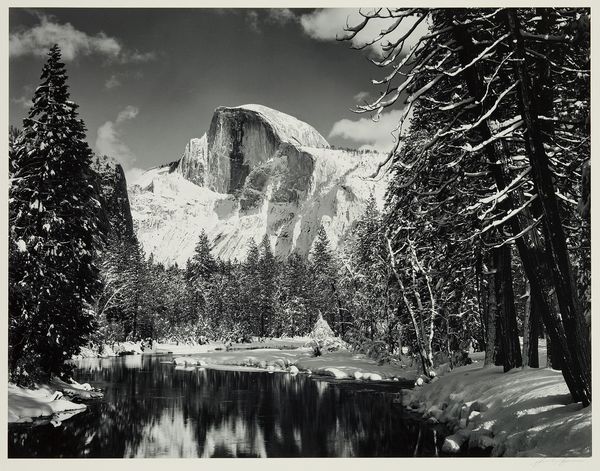Ed Ruscha God Knows Where, 2014. Estimate: £2,500,000-3,500,000.
20th Century & Contemporary Art Evening Sale at Phillips London, 13 February.
A majestic mountain top dominates the background of Ed Ruscha’s God Knows Where, 2014, while the painting’s three eponymous words occupy the foreground, devised in crisp-white paint. Typical of Ruscha’s investigation of the relationship between images and words, the composition is an exceptional example of his use of mountainous peaks as visual backdrops, referencing both the naturalistic theme of snow and the Hollywood appropriation of snowscapes. Silhouetted against a matte sky, the large mountain at the heart of the image resembles the cut-out of a movie set, flattening the adventurous potential of what lies beyond. The text applied with a stencil in Ruscha’s emblematic font is, as the artist explains, "one of my own inventions, which I call 'Boy Scout Utility Modern.' If the telephone company was having a picnic and asked one of their employees to design a poster, this font is what he’d come up with. There are no curves to the letters – they’re all straight lines – and I’ve been using it for years" (Ed Ruscha, quoted in Kristine McKenna, Ed Ruscha: Fifty Years of Painting, exh. cat., Hayward Gallery, London, 2009, p. 58).
The artist with the present work at Ed Ruscha and the Great American West,
de Young Museum, San Francisco, 16 July – 9 October 2016. © Ed Ruscha.
Image: Margo Moritz.
At once precise and elusive, the scene within God Knows Where is identified by its title as placeless, enlivened only by the heightened detail with which Ruscha composes the image. The picture balances the sublime majesty of the mountainous motif with its commonplace commercial appropriation, yet is instantly interrupted by the presence of the text. Indeed, as the opaque letters obfuscate the alpine view, the landscape dissipates behind the exercise of painting itself. "I like the idea of a word becoming a picture, almost leaving its body, then coming back and becoming a word again," Ruscha explains (Ed Ruscha, quoted in Calvin Tomkins, "Ed Ruscha’s L.A.," The New Yorker, 24 June 2013, online). With God Knows Where, Ruscha presents an homage to linguistic and iconographic form, fusing their distinct appearances into a single graphic whole.
Ansel Adams Half Dome, Merced River, Winter, Yosemite Valley, circa. 1938, printed between 1963 - 1971, gelatin silver print, Detroit Institute of Arts, Detroit.
© The Ansel Adams Publishing Rights Trust.
Image: Founders Society Purchase, John S. Newberry Fund / Bridgeman Images
Art historically, mountainous imagery has always been understood as "a shorthand for the sublime, from the pantheist canvases of Caspar David Friedrich and the Catskills of the Hudson River School to Ansel Adams’s photographs of the Rockies," Martha Schwendener comments. "But Ruscha resists knee-jerk spiritualism by emblazoning slogans that render the scenes absurd" (Martha Schwendener, "Ed Ruscha—Reviews," Artforum, New York, November, 2002, online). Indeed, the artist expands on the notion of arbitrary absurdity, presenting his own layered reasons of how the dramatic landscape elements came about. "The mountains emerged from my connection to landscape, and experiencing it, and especially from driving across country. They’re based on specific mountains and alterations and photographs […] They’re ideas of mountains, picturing some sort of unobtainable bliss or glory—rock and ways to fall, dangerous and beautiful" (Ed Ruscha, quoted in Adam Gopnik, Ed Ruscha Paintings, Toronto, 2002, p. 7).
A deserted landscape containing the luminous powers of the sun as its shafts reflect upon snowy grounds, God Knows Where perfectly embodies Sterling Ruby’s claim that "For me, [Ed Ruscha’s] work represents the perfect balance of the apocalypse and serenity. It’s almost like it’s symbolizing some sort of dichotic meditation on existence" (Sterling Ruby, "Ed Ruscha," Interview Magazine, 20 August 2016, online). At once deafeningly mute and peacefully composed, God Knows Where indeed conjures the precarious paradox that dawns on the ambivalent notions of stillness and silence. Pairing a cinematic mountain as seen in travel books, posters, postcards and adventure movies, with a conversational expression conveying cluelessness, the painting stands as a superior example of Ruscha’s formulaic artistic program of Word Paintings.


